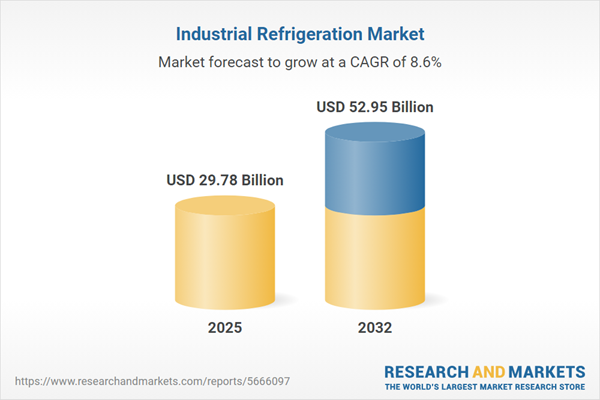Speak directly to the analyst to clarify any post sales queries you may have.
Industrial refrigeration is experiencing a dynamic shift as organizations adapt to emerging technologies and ambitious sustainability expectations. Today's senior decision-makers navigate a more intricate landscape, balancing evolving regulatory demands with strategies for both compliance and long-term resilience.
Market Snapshot: Industrial Refrigeration Market Overview
The global industrial refrigeration market is currently valued at USD 27.45 billion and is forecasted to reach USD 29.78 billion in the following year, with projections indicating further expansion to USD 52.95 billion by 2032. This upward trend is attributed to steady investment in advanced refrigeration technologies and a commitment to energy-efficient operations. Across key sectors such as food and beverage, healthcare, pharmaceuticals, and cold storage, consistent demand emphasizes the necessity for robust and reliable temperature control systems. As both established providers and new entrants strengthen their modernization efforts, leadership is prioritizing solutions designed to bolster operational flexibility while meeting stringent industry and environmental expectations.
Scope & Segmentation of the Industrial Refrigeration Market
- End User Industries: Chemicals, petrochemicals, food and beverage, pharmaceuticals, marine, healthcare, retail, and cold storage industries depend on precise, energy-aware temperature management to ensure regulatory compliance and asset protection.
- Temperature Ranges: Refrigeration systems that manage low to ultra-low temperatures safeguard pharmaceutical products and perishable goods, enabling dependable logistics and quality control across diverse applications.
- Cooling Capacities: Solutions available span compact units for mission-critical tasks to expansive refrigeration systems for high-volume facilities, supporting a spectrum of operational demands.
- Installation Types: Organizations select between retrofit projects and new installations, focusing on lifecycle extension, risk reduction, and keeping pace with current technical standards.
- Sales Channels: Direct procurement from manufacturers, complemented by aftermarket services and specialized provider support, enhances procurement efficiency and operational uptime in sensitive environments.
- Key Components: Advanced centrifugal, reciprocating, and rotary screw compressors, paired with high-efficiency condensers and evaporators, underpin system reliability and sustained performance.
- Refrigerants: Options encompass ammonia, carbon dioxide, HCFCs, HFCs, and innovative sustainable alternatives, supporting customers facing evolving compliance requirements and environmental objectives.
- Regions Covered: Demand and technology adoption rates vary worldwide, with the Americas, Europe, Middle East, Africa, and Asia-Pacific shaped by local policies and cost considerations.
- Leading Companies Analyzed: The market review includes Johnson Controls International, Carrier Global, Daikin Industries, Danfoss, GEA Group, Bitzer SE, Evapco, Emerson Electric, Mitsubishi Electric, and Ingersoll Rand, reflecting influences on innovation and global industry standards.
Key Takeaways for Senior Decision-Makers
- Deployment of IoT-driven monitoring and predictive analytics tools enables early identification of equipment maintenance needs, facilitating proactive interventions and minimizing system downtime.
- Continuous evaluation of refrigerant options is essential as regulations evolve; this ensures ongoing compliance and supports sustainability objectives globally.
- Investment in modular and adaptive infrastructure allows organizations to remain responsive during periods of operational volatility, supporting stable performance amid shifting market or supply variables.
- Streamlining engineering and maintenance cycles extends asset life and supports uninterrupted business activity, increasing operational resilience in critical segments.
- Cultivating strong supplier networks—particularly regionally—enhances cost controls and bolsters risk management strategies in the face of changing policies or logistics disruptions.
- Adapting compliance approaches to the specific requirements of local markets helps multinational organizations improve efficiency and reduce cross-border complexity.
Tariff Impact: Navigating US Trade Policy Changes
Changes to steel and aluminum tariffs in the United States are prompting companies in the industrial refrigeration market to refine sourcing strategies. Building deeper collaborations with regional suppliers helps mitigate cost volatility while enhancing the agility needed for rapid shifts in procurement and supply chain management.
Methodology & Data Sources
This report derives its insights from direct discussions with industry executives and technical experts, supported by a rigorous examination of regulatory texts. The findings represent authentic viewpoints and current challenges faced by senior leaders in the industrial refrigeration sector.
Why This Report Matters
- Empowers executive teams to make informed capital planning and risk management decisions in an environment shaped by ongoing uncertainty and evolving regulations.
- Provides actionable recommendations for digitization, compliance with new standards, and evaluation of expansion opportunities for robust global operations.
- Enables improved supplier selection strategies and procurement processes, resulting in greater resilience and adaptability across varied business conditions.
Conclusion
This analysis delivers actionable guidance for organizational leaders to enhance compliance, streamline operational practices, and strengthen their company’s strategic position in the evolving industrial refrigeration marketplace.
Additional Product Information:
- Purchase of this report includes 1 year online access with quarterly updates.
- This report can be updated on request. Please contact our Customer Experience team using the Ask a Question widget on our website.
Table of Contents
3. Executive Summary
4. Market Overview
7. Cumulative Impact of Artificial Intelligence 2025
Companies Mentioned
The companies profiled in this Industrial Refrigeration market report include:- Johnson Controls International plc
- Carrier Global Corporation
- Daikin Industries, Ltd.
- Danfoss A/S
- GEA Group AG
- Bitzer SE
- Evapco, Inc.
- Emerson Electric Co.
- Mitsubishi Electric Corporation
- Ingersoll Rand Inc.
Table Information
| Report Attribute | Details |
|---|---|
| No. of Pages | 187 |
| Published | October 2025 |
| Forecast Period | 2025 - 2032 |
| Estimated Market Value ( USD | $ 29.78 Billion |
| Forecasted Market Value ( USD | $ 52.95 Billion |
| Compound Annual Growth Rate | 8.5% |
| Regions Covered | Global |
| No. of Companies Mentioned | 11 |









